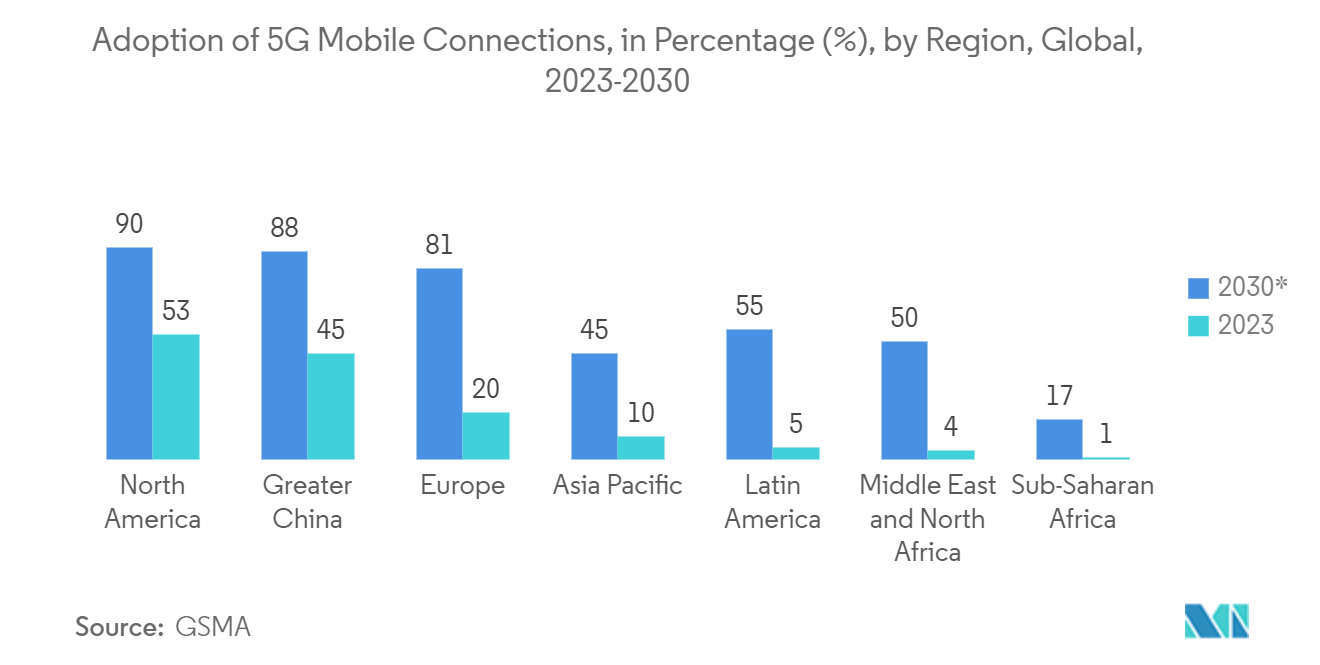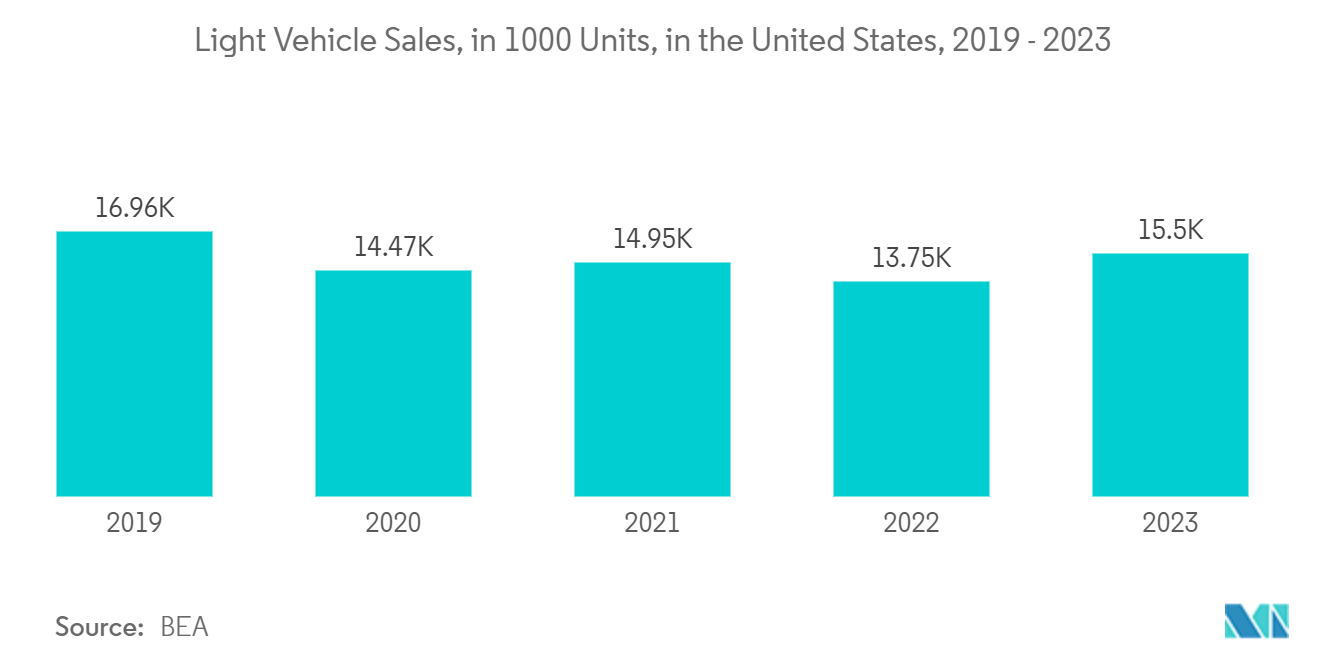Market Trends of Americas Flash Memory Industry
NOR Flash is Expected to Witness Faster Growth Rate
- NOR flash is a type of memory and one of the non-volatile storage technologies. It is used in applications where single bytes of data must be written and read. The products are designed to provide lower memory densities than NAND and to reduce power consumption in end-user devices.
- The rising demand for NOR flash memory in consumer electronics and communication devices, the emergence of data-centric applications, and the need for increased storage capacity drive the market studied over the forecast period. Furthermore, the increasing emphasis on AI for wearables, consumer electronics, and other applications is becoming a disruptive trend, increasing memory size requirements, which drives the NOR memory devices.
- Moreover, because embedded computing devices such as wearables or small IoT devices frequently use NOR flash memory to store very small amounts of executable code, such patterns highlight the enormous demand in the region for the market under consideration. According to CTA, 22 million homes in the United States already use IoT or smart technology to make life easier. The smart home market is expected to generate USD 23.5 billion in revenue by 2023. (23.2 billion USD in 2021) which creates the need for Flash memory-based devices.
- To meet demand and maintain a competitive edge in the market, major vendors in the area are constantly investing in various product innovations, acquisitions, and expansions. For example, in August 2022, Micron, the company that owns the Crucial RAM brand, announced a USD 40 billion investment over the next ten years to build cutting-edge memory production facilities in the United States. One of the major factors driving demand for NOR Flash devices is the company's intention to manufacture memory chips after 2025.
- In addition, Microchip announced the SST26LF064RT, a 64-Mbit serial quad I/O NOR flash memory device for demanding aerospace and defense systems, in April 2022. The COTS memory technology device is radiation resistant and can operate in a total ionizing dose (TID) environment of 50 kilorads (krads). Microchip's second SuperFlash device was designed to reduce system development time, cost, and risk. Such advancements are expected to propel the market.
- The region's industrial segment is also expected to drive the market for a significant share. In robots, NOR flash is used as an embedded device for code execution. With the increased adoption of industrial robots in the region, the market for NOR Flash memory is expected to grow rapidly. According to IFR, robotic installations in the Americas will have 60,000 units by the end of 2024. Such factors will drive the need for flash memory devices to be installed in various applications.
- Furthermore, implementing the 5G network has fueled the market's post-lockdown expansion. According to CTIA, 5G networks cover over 315 million Americans, one in every three American adults owns a 5G device, and 5G is the fastest-growing market for home internet. Furthermore, the GSMA predicts thatBy 2030, North America is poised to lead the global charge in 5G adoption, with a projected rate of 90%. Such factors will also drive the demand for NOR Flash memory devices in the communications sector.

Automotive is Expected to Drive the Market
- The Americas is a significant market in the automotive industry. The total number of vehicles produced in the United States alone accounts for a significant portion of global production. The demand for Flash memory devices used in automotive applications has steadily increased. For example, NOR Flash is used in infotainment and engine control applications. However, as advancements in automotive computerization continue, Flash memory devices are finding use in a broader range of automotive applications.
- For instance, NOR Flash memory, in particular, has seen rapid demand growth in advanced driver-assistance systems (ADAS), digital instrument clusters, and infotainment systems. One of the primary factors driving demand for these systems in recent years has been growing awareness of the importance of ADAS in reducing car accidents. Many countries in the Americas have passed legislation requiring various types of ADAS in passenger vehicles. For example, since 2018, new vehicles sold in Canada must have a backup camera, an ADAS feature.
- The growing popularity of self-driving or autonomous vehicles is a significant growth driver for the ADAS market, necessitating the installation of Flash memory devices in vehicles. Furthermore, high-capacity NAND Flash memory modules are essential in various automotive applications and systems. To succeed, the transition to autonomous and electrically powered vehicles and the resulting transition to a centralized vehicle architecture requires high-performance, high-bandwidth, stable, and secure memory. With increased global sales of cars and EVs, demand for memory products is expected to rise.
- Storage devices are expected to last as long as the vehicle is on the road and meets automotive-grade qualifications. Automakers, Tier 1 system designers, and other critical stakeholders in the automotive supply chain are quickly adopting NAND flash storage solutions such as embedded Multimedia Card (eMMC), Universal Flash Storage (UFS), and Solid-State Drives (SSD) for performance, reliability, longevity, and security considerations.
- Micron Technology, Inc., for example, announced in March 2022 that it had begun volume production of the world's first 232-layer NAND, built with industry-leading innovations to drive unprecedented performance for storage solutions. Micron's 232-layer NAND technology enables high-performance storage for advanced solutions and real-time services in data centers and automotive applications. Such advancements are expected to drive the demand for Flash memory devices catering to the Automotive segment.
- The flash memory market is expected to be driven by advanced driver assistance systems (ADAS) applications, infotainment/telematics, and cluster/instrumentation in the Canadian automobile industry. Furthermore, motor vehicles and parts are one of Canada's two most important manufacturing industries, according to Canadian Manufacturers and Exporters. Furthermore, increased memory and storage device demand for next-generation connected automobiles and automotive safety systems is driving market growth.


